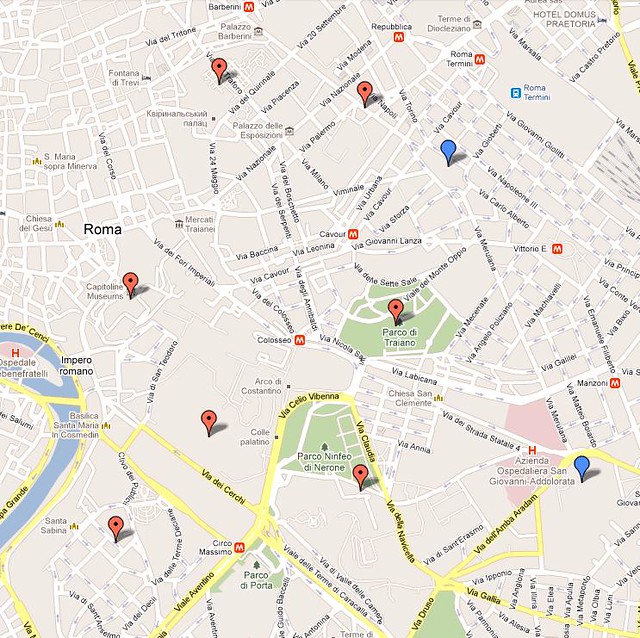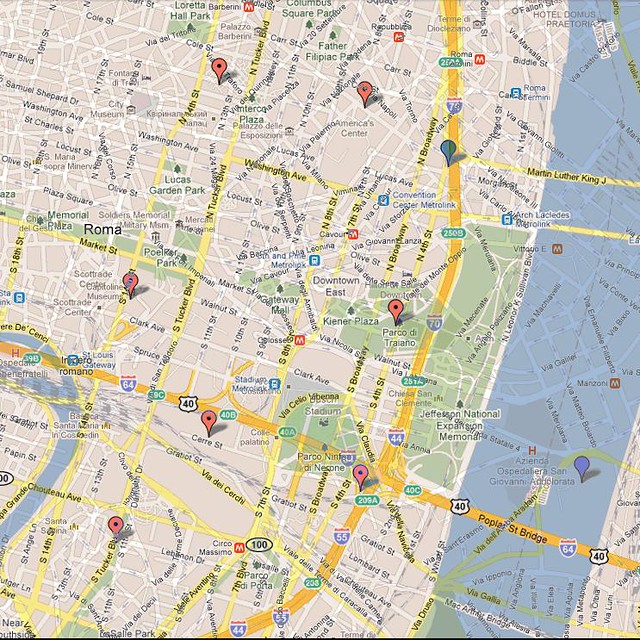
This map shows the approximate locations of the famed Seven Hills, shown here by red markers. The area includes tourist attractions such as the Coliseum and Forum, as well as the palaces of government — from the Roman period, through the Papal States, to present-day Italy. Wars were fought over these hills, which are located within short walking distance from each other. The original Google map is here.
I haven't been to Rome in ages, but I recall it being quite walkable. Sometimes it is hard getting a sense of distance, so I got a map of my hometown of Saint Louis, at the same scale. It turns out that central Rome, with its seven hills, is approximately the same size as downtown Saint Louis, which also happens to be quite walkable.

The original map is here. Native Saint Louisians ought to surprised at the small size of this part of Rome. Because of its fame, ought it be bigger? It is rather on a human scale.
For fun, I did a little exercise in comparative geography. I took these two maps, which are at the same scale, and placed the Colosseum directly upon the location of the old Busch Stadium. [The old Busch design was inspired by the Coliseum. The current Busch has a more American form and is a bit south of the original location.] Assuming this juxtaposition:
- Esquiline Hill is around the Old Courthouse, Old Cathedral, and Kiener Plaza.
- Viminal Hill would be over the Convention Center and Laclede's Landing
- Quirinal Hill is superimposed on the Post Dispatch Building, Catholic Charities housing, and the City Museum.
- Capitoline Hill would crush City Hall and the Scottrade Center hockey arena.
- Caelian Hill is lurking at Saint Mary of Victories and the foot of the Poplar Street Bridge.
- Palatine Hill is a disappointing parking lot between the Highway 40 overpass and Purina headquarters.
- Aventine Hill would be found at the Maronite Cathedral.
Of the four major basilicas, two of them are found here, and the others are not far away:
- Saint John Lateran is, sadly, in the Mississippi River, as seen by a blue marker in the composite map below.
- Saint Mary Major majestically sits over I-70, at the on-ramp to the Martin Luther King Bridge.
- Vatican City is at Saint Louis University and the Fox Theater, while Saint Peter's Basilica overwhelms the otherwise huge Saint Francis Xavier Church.
- Saint Paul Outside the Walls is down at the Anheuser-Busch brewery.

The Tiber is rather small compared to the Mississippi, and is much easier to swim across.
Rome was founded on the Palatine Hill, and Saint Louis had its origins where the Gateway Arch now stands, which is the green area labeled the Jefferson National Expansion Memorial. Sadly, little remains from the founding of the City nearly 250 years ago.
The burden of history is too much for some people to bear, and so Modernists want to bulldoze history and flatten the hills for the impossible ideal of creating a new world uninfluenced by the past. Romantics on the other hand like to look at vine-covered ruins, as this helps them get into an aesthetically depressed mood. But why not incorporate the past into the present? Why destroy something only because it is out of style, and why should old monuments become sterile archaeological museums, as we see now in the Roman Forum?
Catholic culture, traditionally, has a more organic connection with the past, which we find in Rome. Layer upon layer of buildings can be found, with newer buildings incorporating scraps of older ones, and older buildings finding new uses. Even place names layer upon each other, like the Basilica of Santa Maria sopra Minerva, which as its name hints, is a Catholic church built over the ruins of a pagan temple. Buildings can even have multiple names: the presidential palace can also rightfully be called the royal palace and the Papal palace. The Pantheon is also Saint Mary of the Martyrs and Santa Maria Rotonda.
The time between Rome's founding until it became a republic is about the same amount of time since the founding of Saint Louis in 1764 to now. Saint Louis was founded as a colony of an empire even greater than Imperial Rome, and so what it lacked in sovereignty, it gained in trade. But men of business and government tend to look forward, and have little respect for the past. We have very little knowledge of the people who lived here before the French — for it was not recorded — and nearly all of the prehistoric Indian mounds in the city have been destroyed by progress.
There are at least five layers of history in old downtown Saint Louis: the native population, the French and Spanish village, the first wave of warehouses (destroyed by fire), a second wave of warehouses, and now the Gateway Arch. Modern bulldozers and digging equipment go deep to uncover virgin soil, and so relics of the past may be hard to come by, although clever searchers can sometimes find old items if they know where to look. Examining the riverfront during times of extremely low water can turn up the remains of many old sunken steamboats, as well as the mouths of springs which drain undiscovered caves beneath the city.
Rome's history is ten times that of Saint Louis, but even the history of the newer city can be quite hazy. The official history of Saint Louis very often is just the history of downtown. Relatively little is known about the history of other settlements that were absorbed by the growing municipality: this knowledge is often found in obscure archives or by local amateur historians of neighborhoods, and is often passed on through word of mouth.
In my opinion, the past is not a burden but rather is a great, unearned, Providential gift. It is a largely undiscovered storehouse of wisdom and guidance. It has been revealed to us that God even considers the fall of a sparrow, and so history — ever-present to Him — is of no insignificance.


Very interesting! Thanks for doing the map work.
ReplyDelete